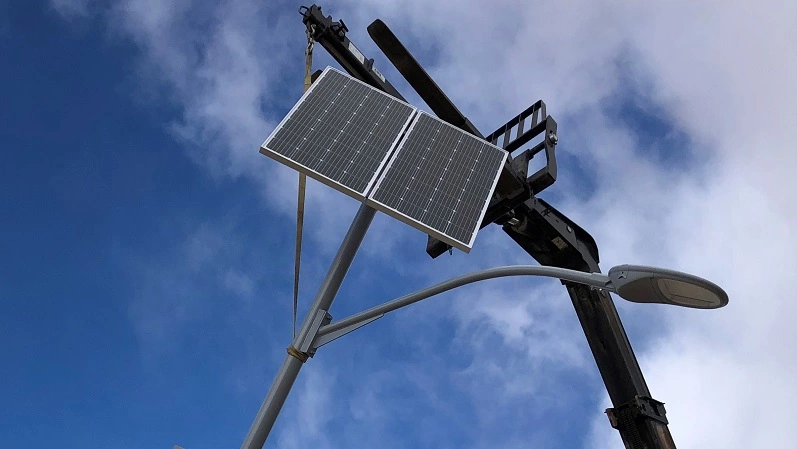LED Streetlights vs HPS Streetlights: What's the Diff?Posted by Stephen Shickadance in Solar FAQs.
DOWNLOAD SOLAR LIGHTING GUIDE A lot of people ask us what the difference is when it comes to solar LED streetlights vs HPS street lights. You may think that there aren't a lot of differences between the two lighting technologies, but that couldn't be farther from the truth. Prepare yourselves, we're breaking down a big comparison in street lighting today! We're discussing the comparisons between light-emitting diode (LED) and High-Pressure Sodium (HPS) lighting systems, and hopefully by the end of this lesson we can educate you and ensure your wallet stays happy. Here are some main differences between LED streetlights vs HPS streetlights. Hint: LED streetlights win this battle. What is the Difference Between LED Streetlights and HPS Streetlights?The answer to this lies in lumens. A quick search reveals that a lumen is defined as "the SI unit of luminous flux, equal to the amount of light emitted per second in a unit solid angle of one steradian from a uniform source of one candela." We don't prefer to baffle our readers with jargon, so for our reasons lets just define a lumen as the standard of how light is measured when we discuss solar LED street lights vs HPS street lights. That term is primarily used in discussing efficiency behind lighting--how much light you get per energy invested. A standard "return on investment," if you will, for light. The efficiency for LED lights ranges between about 40 and 120 lumens per watt. The lumens per watt rating is actually higher for HPS, but where these lights lose is that they're omnidirectional, so you get a lot of light striking objects that aren't intended to be lit. The difference between led vs hps lumens per watt is greater because there's less "loss" of light. LEDs have a light spread of 180 degrees, and so more light is actually directed towards the subject in question. Why bother buying a kind of light if half of what it emits goes the opposite direction of where you want it to go? LED wins this bout. High-Pressure Sodium: Hot, Hot HeatHigh pressure sodium lights produce heat--not something you'd really want when your main concern is just illuminating something. The heat emitted from the light either wafts out into the great wild or is absorbed by the ballast. Turning that heat back into light is ideal--or by using a light that emits very little heat whatsoever. In this case, LED lights win again since hardly any heat comes from them. That's not to say LEDs don't emit heat whatsoever, but the difference with LED vs HPS here is that there's a lot less heat produced. More energy goes into the actual light emittance. LED vs HPS - LED Wins with Longevity OverWe'll admit that HPS lights have fantastic longevity, which is oftentimes why they're chosen to light parking lots and wide public areas. However, LED lights still win in this category--surprise--with a whopping 25 thousand hours of usage time vs a max of 24 thousand hours with HPS before failure. It's marginal, but we're sure when weighing options that a little more time is better than a little less. LED beats out HPS in this category regardless. What Are LED Streetlights - Maintenance, Money, Maximum Brightness, and More!Here's where LED really shines, so to speak. remote LED solar street lights require virtually no maintenance. The bulbs last so long they beat out all the competition in terms of longevity and so don't need a replacement for several thousands of hours, unlike HPS. So less maintenance requires less money—you get the idea. Plus, LEDs have a more accurate color reproduction. We're sure you've been under HPS lights before, and they cast an unsightly yellow color over everything! That's not exactly the most pretty of colors. Color ReproductionWe're sure you've seen HPS lights in public before. They tend to cast a very ugly yellow glare on subjects in their light throw, so color reproduction underneath them is shoddy at best. Not convinced? Check the image below. The two cars side-by-side appear to be the same color, and yet one of them is actually red. LED lights and solar LED street lamps are different than HPS lights because they reproduce natural colors more accurately. This helps in applications of security when you need to identify colors—or also when you just need to find your car.
By Darkest tree - Own work, CC BY-SA 4.0, https://commons.wikimedia.org/w/index.php?curid=64836710 Time to Full BrightnessOne often overlooked benefit of LED over HPS lights is that LEDs turn on instantly. This makes them fantastic for security reasons since they can be attached to motion sensors and instantly turn on with the slightest hint of movement. That's not the case with HPS lights—these can take up to 10 minutes to get to full brightness. That completely negates an entire application of security for HPS lights. The Differences Between HPS Streetlights and LED Streetlights in a NushellWe hope this was a revealing article! The benefits of LEDs are heavy in comparison to HPS lights, and even better when you combine them with solar panels. If you're considering a switch or are convinced here of the superiority of LED lights, feel free to contact us for further information. We're invested in getting the best possible lights to you.
SOLAR LED STREET LIGHT MANUFACTURERSStreet solar led lights are an efficient way to drastically decrease electricity bills. Our 100% off-grid system helps you save big money as it does not require trenching and has low maintenance costs over time. Greenshine has numerous years of experience in developing smart led street lights and solar led street lamps. Our engineers will provide you with lighting photometric simulations, layouts specific to your application, and appropriate system configurations for your local solar conditions
Solar FAQs
|
ArchivesNo Archives Categories
Want More Info? |
LATEST NEWS & ARTICLES

